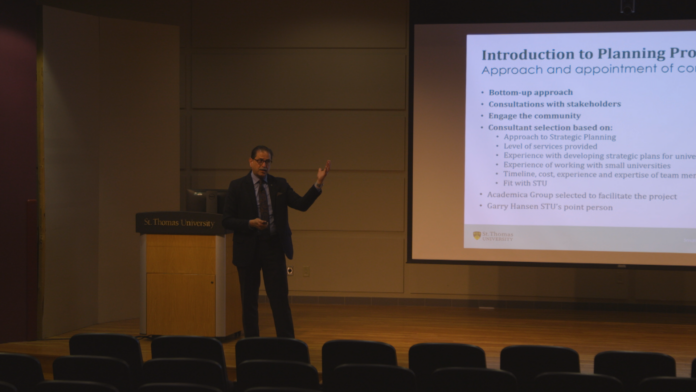
STU president Nauman Farooqi officially launched the university’s strategic planning process with a presentation at Kinsella Auditorium on Jan. 15.
This strategic plan will be the first one since the 2013-2018 plan which was extended until 2019. After getting through the pandemic, the university feels a new plan is appropriate to give a common direction for faculty, staff and students.
“I want to allow the strategic plan to enable us to be on the same page as a community, so we know where we’re going,” said Farooqi, who has been at the university’s helm for six months.
Related: Getting to know Nauman Farooqi, STU’s next president and vice-chancellor
Farooqi said he understands the position the university’s finances and admissions have been in the past decade. He made the net negative financial position and slow decline in admissions a key part of his town hall presentation. He compared the university’s financial position to an ordinary household.
“Imagine a household in which you’re spending more than you’re earning. That’s not financially viable … something has to be done about that,” said Farooqi.
STU’s enrollment has declined from 2,070 students in 2014 to 1,642 in 2023. The 2013-2014 school year was also the last year STU was financially net positive – a place Farooqi wants to get back to.
A few hundred students enrolled could be the difference for STU to return to a financially positive state. Citing STU’s share of full-time undergraduate arts students in the Maritimes, Farooqi knows these students are out there.
STU’s share has decreased from 11.4 per cent in 2013 to 8.7 per cent in 2022. This decrease is just over 300 students, which would represent an estimated $2.7 million in tuition.
Where STU sits now, in an operating deficit of $921,964, $2.7 million in tuition would propel the university into a net positive state.
Solving these problems, the president wants the process to be “bottom-up,” including consultation from students, faculty and staff.
“We want to hear from the community, we want to hear from the different stakeholders,” said Farooqi.
Farooqi thinks that all students can contribute to the process with “new energy and new ideas” as he knows he can’t solve the university’s problems on his own.
“I may have been appointed captain of the team, but I cannot score … we all have to work as a team,” said Farooqi.
The president anticipates unexpected change for the university’s future and wants the strategic plan to reflect that.
“It’s a living document. As you go forward, things happen you don’t have control over things … then you have to pivot and make changes.”
